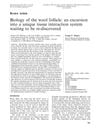Characterization of an Ovine Keratin Associated Protein Gene, Producing a Protein Rich in Glycine and Tyrosine, Lacking in Cysteine
October 2019
in “
Genes
”
TLDR A new sheep gene, KRTAP36-1, may help breed sheep with better wool by reducing prickle factor.
The study identified a novel ovine keratin-associated protein gene, KRTAP36-1, which produced a protein rich in glycine and tyrosine but lacking cysteine, distinguishing it from other known KAPs. This gene was located on sheep chromosome 1 and was not found in humans. The research involved 415 sheep and revealed three variants and four SNPs, with variant B associated with increased prickle factor (PF) in wool. The absence of cysteine suggested alternative cross-linking mechanisms, such as ring-stacking and hydrogen bonding, which could strengthen wool fibers. The study highlighted the potential of KRTAP36-1 as a genetic marker for breeding sheep with reduced PF, adding value to fine wool production.


